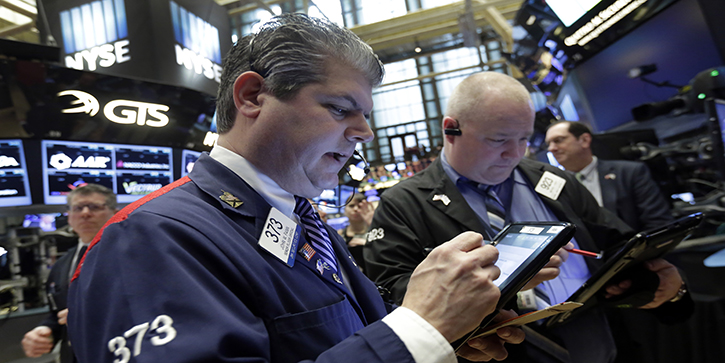
The Dispersion Trade
-
 Jared Dillian
Jared Dillian
- |
- December 8, 2016
- |
- Comments
It is also arbitrageable—if there is a price discrepancy between futures on the index and the underlying stocks, you can buy one and sell the other and make an arbitrage profit.
This is freshman year capital markets stuff.
What a lot of people don’t know is that there is a mathematical relationship between index options and options on the constituent stocks that comprise the index.
As it turns out, index options tend to be chronically overpriced, so there is money to be made by selling index options and buying single-stock options, dynamically hedging along the way. The math behind this is all pretty complicated.
The dispersion trade has been around for a while, but in the early days, it wasn’t easy to effect because of wide bid-ask spreads. There were a few floor market-makers that traded dispersion quite profitably, though, most notably, Timber Hill1.
Timber Hill had a sophisticated operation involving dozens of traders on trading floors around the world. These traders weren’t terribly sophisticated (the guy in our pit was a former construction worker), and they all had a handheld computer that just told them what options to buy or sell.
There was a giant computational engine in headquarters somewhere that identified which index options had to be sold and which single-stock options had to be bought, then fed that information to the handhelds of the traders on the floor. I’m sure they cleaned up.
At Lehman Brothers, we had one person dedicated to the dispersion trade and nothing else. She sat on the corner of the floor and talked to no one. Rumor was that she made more money than all of us put together.
So if you are a dispersion trader, you’re essentially trading correlation, which is the idea that stocks all move together or they don’t.
When correlation is high—that is, stocks are moving like a marching band—the dispersion trade is unprofitable. When correlation is low—that is, when stocks are moving all over the place—the dispersion trade is very profitable. Basically, a dispersion trader prays for the market to stand still, with giant moves in single stocks.
Which is basically what’s happening right now.
Last Chance to Get Jared’s ETF Master Class for just $99!Many hundreds of 10th Man readers have already bought this one-of-a-kind video course that teaches you all you need to know about the treacherous world of ETFs: why they can be dangerous to your portfolio… why even professional money managers misunderstand them… and how you can make them work for you. Today, December 8, is the last day Mauldin Economics offers Jared’s comprehensive ETF Master Class at the beta price of just $99. The offer expires at midnight, so click here to claim your copy now. |
This Can’t Be Hard
I think the post-Trump environment is a pretty easy trade, but for a lot of people, it isn’t. You’ve had massive dispersion on a sector basis (financials going up, utilities going down), and for once, people have something they can trade, and they are screwing it all up.
They are not used to correlation being low. They are used to correlation being high. Meanwhile, yes, stocks are up, but not significantly—they’re statistically unchanged, and then, you have Bank of America (BAC) up 30% in a matter of weeks.
Like what you're reading?
Get this free newsletter in your inbox every Thursday! Read our privacy policy here.
And my answer is, yes, unequivocally.
This is the new regime; get used to it. And it is being driven primarily by interest rate expectations.
We’ve been over this before. Rates have shot up, because:
- Trump is going to dump supply on the market
- Trump is going to cause inflation
- Mnuchin is going to issue as much paper as possible in the ultra-long sector
High interest rates are:
- Good for banks
- Bad for utilities
This is a huge oversimplification, but I’m all in favor of keeping things simple.
So if that really was the turn—if we are now in a bond bear market, instead of a bond bull market—and the bear market lasts 5, 10, or 35 years…
The dispersion is going to continue.
But This Is Good News!
The last eight years have been awful, and that is not a political statement. Sure, the market went up 200%, but it was awful.
It was the toughest trading environment known to man. And it drove a lot of people toward passive strategies. Vanguard has taken in something like $270 billion this year. It’s insane.
Nothing would make me happier than an environment where some stocks go up a lot and some stocks go down a lot. This is the type of environment where an active manager or a discretionary trader can really add value.
So start adding value!
Or else you are going to simply prove what all these people have been saying for the last eight years, which is that everyone should just put their money in index funds and be done with it. Although if you really believed that, you would probably not be reading this newsletter.
I seem to remember it being easier to make money in the 1990s. I also recall that interest rates were higher in the 1990s. I think there might be a connection. So this is really like Back to the Future, in a way.
It’s been said that something like two-thirds of traders today can’t even remember a time when we had non-zero interest rates.
I remember.
Like what you're reading?
Get this free newsletter in your inbox every Thursday! Read our privacy policy here.
One postscript: I talked a lot about options in this piece, and I’m sure the whole discussion of the dispersion trade went over most people’s heads. I might teach an options course someday. We’ll see.
But in the interim, I have a book recommendation for you. I was given an advance copy of Managing Expectations by Tony Saliba, one of the original Market Wizards, which is being released next month.
When I was on the trading floor, I was raised on the Sheldon Natenberg book, Option Volatility & Pricing, but this is even better. I think it’s going to be the new standard by which all options books are judged. Check it out.
I should also mention that Mauldin’s VIP offer—get six premium services at one low price—is expiring next week. Street Freak is one of those six services, so I have a vested interest in getting you to sign up… but most of all, I think you owe it to yourself to get the widest spread of investment advice in this new low-correlation world. Get the details here.
___________________________________________________
1You might know Timber Hill by its latest incarnation, Interactive Brokers.
subscribers@mauldineconomics.com
Tags
Suggested Reading...
|
|

 Jared Dillian
Jared Dillian

